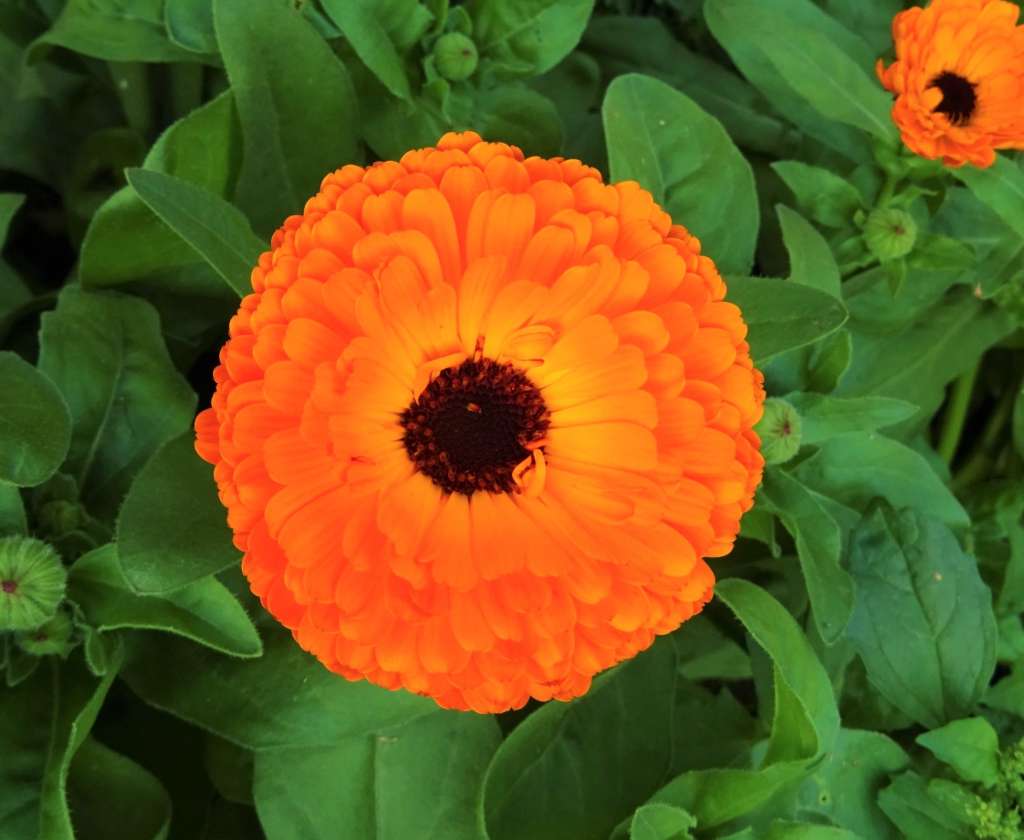Calendula officinalis: A Clinical Snapshot

By Todd Hoover, MD
July 1, 2018
Calendula officinalis has a long-standing history of traditional herbal use for skin irritations and infections. A tincture of the flowering tops of the common marigold is used to prepare the homeopathic products of this plant. Traditional homeopathic uses for Calendula officinalis often focused on the helpfulness of this medicine for skin injuries that do not heal well or result in infection of the wound. This indication has been expanded to include gum irritations or persistent bleeding after tooth extraction, anal fissures, and vaginal irritations. The homeopathic medicine is typically used topically in tincture or low attenuation for these purposes. Additionally, Calendula officinalis has also been used in patients with oral and skin cancers. Interestingly, some of the current day research has focused on the usefulness of the herbal tincture in treating or preventing burns when radiation therapy is used to treat cancer.
Considerable research has been done on topical, anal, and vaginal products using Calendula officinalis. A brief review of the literature shows research demonstrating likely effects of Calendula officinalis when used to treat the following.
- Anal irritation or fissures
- Foot ulcers (in patients with diabetes mellitus)
- Diaper rash
- Lip peeling or desquamation
- Gum irritation and plaque formation
- Ear pain
- Vaginal irritation and painful intercourse
- Ulcers of the legs
- Skin irritation from radiation therapy
- Skin inflammations
- Promoting healing from injuries
(See references below.)
The clinical hallmarks for the homeopathic use of Calendula officinalis include the following:
- Wounds that do not heal properly (e.g. take too long to heal or heal with excessive scar formation).
- Wounds or injuries to the skin or gums that bleed excessively or become infected.
- Injuries that seem to be overly sensitive or painful compared to the extent of the injury. Pain may be sharp.
- Burns of the skin.
- Chapped skin of the hands or lips.
- Skin irritation of the nipples during nursing.
- Problems are often associated with restlessness or nervousness of the individual.
The primary sphere of action of Calendula officinalis appears to be on the skin and mucus membranes. Some authors have reported success using the medicine for deeper issues such as cancer or as an adjunct to treating certain aspects of cancer.
The extensive research done on this medicine has also given us valuable information on potential interaction with commonly used drugs. Like many medicines, the risk of use of Calendula officinalis either topically or orally during pregnancy or nursing is unknown. When taken orally in tincture form, Calendula officinalis has been reported to cause drowsiness. For this reason, use with other sedating medicines may compound or increase the sedative effect of those drugs.
References
Benomar, S., Boutayeb, S., Lalya, I., Errihani, H., Hassam, B., and El Gueddari, B. K. [Treatment and prevention of acute radiation dermatitis]. Cancer Radiother. 2010;14(3):213-216.
Chargari, C., Fromantin, I., and Kirova, Y. M. [Importance of local skin treatments during radiotherapy for prevention and treatment of radio-induced epithelitis]. Cancer Radiother. 2009;13(4):259-266.
de, Andrade M., Clapis, M. J., do Nascimento, T. G., Gozzo, Tde O., and de Almeida, A. M. Prevention of skin reactions due to teletherapy in women with breast cancer: a comprehensive review. Rev.Lat.Am.Enfermagem. 2012;20(3):604-611.
Della Loggia R. and et al. Topical anti-inflammatory activity of Calendula officinalis extracts. Planta Med 1990;56:658.
Della, Loggia R., Tubaro, A., Sosa, S., Becker, H., Saar, S., and Isaac, O. The role of triterpenoids in the topical anti-inflammatory activity of Calendula officinalis flowers. Planta Med 1994;60(6):516-520.
Duran, V., Matic, M., Jovanovc, M., Mimica, N., Gajinov, Z., Poljacki, M., and Boza, P. Results of the clinical examination of an ointment with marigold (Calendula officinalis) extract in the treatment of venous leg ulcers. Int.J.Tissue React. 2005;27(3):101-106.
Kassab, S., Cummings, M., Berkovitz, S., van, Haselen R., and Fisher, P. Homeopathic medicines for adverse effects of cancer treatments. Cochrane.Database.Syst.Rev. 2009;(2):CD004845.
Klouchek-Popova, E., Popov, A., Pavlova, N., and Krusteva, S. Influence of the physiological regeneration and epithelialization using fractions isolated from Calendula officinalis. Acta Physiol Pharmacol Bulg. 1982;8(4):63-67.
Kumar, S., Juresic, E., Barton, M., and Shafiq, J. Management of skin toxicity during radiation therapy: a review of the evidence. J.Med.Imaging Radiat.Oncol. 2010;54(3):264-279.
Kundakovic, T., Milenkovic, M., Zlatkovic, S., Nikolic, V., Nikolic, G., and Binic, I. Treatment of venous ulcers with the herbal-based ointment Herbadermal(R): a prospective non-randomized pilot study. Forsch.Komplementmed. 2012;19(1):26-30.
Lievre M, Marichy J, Baux S, and et al. Controlled study of three ointments for the local management of 2nd and 3rd degree burns. Clin Trials Meta-analysis 1992;28:9-12.
Machado, M. A., Contar, C. M., Brustolim, J. A., Candido, L., Azevedo-Alanis, L. R., Gregio, A. M., Trevilatto, P. C., and Soares de Lima, A. A. Management of two cases of desquamative gingivitis with clobetasol and Calendula officinalis gel. Biomed.Pap.Med.Fac.Univ Palacky.Olomouc.Czech.Repub. 2010;154(4):335-338.
McQuestion, M. Evidence-based skin care management in radiation therapy. Semin.Oncol Nurs 2006;22(3):163-173.
Naseer, S. and Lorenzo-Rivero, S. Role of Calendula extract in treatment of anal fissures. Am.Surg. 2012;78(8):E377-E378.
Neto, J. J., Fracasso, J. F., Neves, M. D. C. L. C., and et al. Treatment of varicose ulcer and skin lesions with calendula. Revista de Ciencias Farm Sao Paulo 1996;17:181-186.
Pommier, P., Gomez, F., Sunyach, M. P., D'Hombres, A., Carrie, C., and Montbarbon, X. Phase III randomized trial of Calendula officinalis compared with trolamine for the prevention of acute dermatitis during irradiation for breast cancer. J Clin.Oncol. 4-15-2004;22(8):1447-1453.
Rao, SG, Udupa, AL, Udupa SL, and et al. Calendula and Hypericum: Two homeopathic drugs promoting wound healing in rats. Fitoterapia 1991;62(6):508-510.
Samochowiec L. Pharmacological study of saponosides from Aralia mandshurica Rupr. et Maxim and Calendula officinalis L. Herba Pol. 1983;29:151-155.
Sarrell EM, Mandelberg A, and Cohen HA. Efficacy of naturopathic extracts in the management of ear pain associated with acute otitis media. Arch Pediatr Adolesc Med 2001;155(7):796-799.
Sarrell, E. M., Cohen, H. A., and Kahan, E. Naturopathic treatment for ear pain in children. Pediatrics 2003;111(5 Pt 1):e574-e579.
Tedeschi, C. and Benvenuti, C. Comparison of vaginal gel isoflavones versus no topical treatment in vaginal dystrophy: results of a preliminary prospective study. Gynecol.Endocrinol. 2012;28(8):652-654.
Adib-Hajbaghery M, Mahmoudi M, Mashaiekhi M. The effects of Bentonite and Calendula on the improvement of infantile diaper dermatitis. J Res Med Sci. 2014;19(4):314-8. Buzzi M, de Freitas F, Winter M. A Prospective, Descriptive Study to Assess the Clinical Benefits of Using Calendula officinalis Hydroglycolic Extract for the Topical Treatment of Diabetic Foot Ulcers. Ostomy Wound Manage. 2016;62(3):8-24.
Buzzi M, Freitas Fd, Winter Mde B. Pressure ulcer healing with Plenusdermax Calendula officinalis L. extract. Rev Bras Enferm. 2016;69(2):250-7.
Khairnar MS, Pawar B, Marawar PP, et al. Evaluation of Calendula officinalis as an anti-plaque and anti-gingivitis agent. J Indian Soc Periodontol. 2013;17(6):741-7.
Mahyari S, Mahyari B, Emami SA, et al. Evaluation of the efficacy of a polyherbal mouthwash containing Zingiber officinale, Rosmarinus officinalis and Calendula officinalis extracts in patients with gingivitis: A randomized double-blind placebo-controlled trial. Complement Ther Clin Pract 2016;22:93-8.
Panahi Y, Sharif MR, Sharif A, et al. A randomized comparative trial on the therapeutic efficacy of topical aloe vera and Calendula officinalis on diaper dermatitis in children. ScientificWorldJournal. 2012;2012:810234.
Roveroni-Favaretto LH, Lodi KB, Almeida JD. Topical Calendula officinalis L. successfully treated exfoliative cheilitis: a case report. Cases J. 2009;2:9077.
Saffari E, Mohammad-Alizadeh-Charandabi S, Adibpour M, et al. Comparing the Effects of Calendula Officinalis and Clotrimazole on Vaginal Candidiasis: A Randomized Controlled Trial. Women Health. 2016.
Pazhohideh Z, Mohammadi S, Bahrami N, Mojab F, Abedi P, Maraghi E.The effect of <i>Calendula officinalis</i> versus metronidazole on bacterial vaginosis in women: A double-blind randomized controlled trial. J Adv Pharm Technol Res. 2018 Jan-Mar;9(1):15-19. doi: 10.4103/japtr.JAPTR_305_17.
